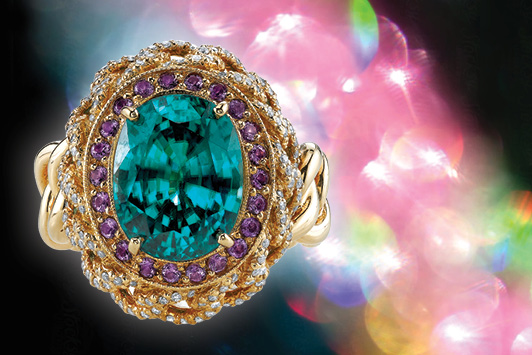
Zircon has been around for a long time — over four billion years, give or take, going by a single atom that scientists at the University of Wisconsin managed to isolate from an Australian sample. People have been mining zircon for over two millennia in Sri Lanka, and the stone appears in biblical writings referencing the high priest’s gem-encrusted breastplate.
With such an ancient lineage, you’d think the world would have had a long love affair with these sparklers. But that hasn’t been the case — and the stone’s name might be the culprit. The lackluster attention zircon has received likely stems from associations with a cheap, similar-sounding simulant, explains Simon Watt, partner at gemstone wholesaler Mayer & Watt.
“Cubic zirconia was ubiquitous in the market for so many years and was an early synthetic in the public consciousness,” he says. “As soon as they hear zircon, zirconia raises its ugly head.”
Now, though, consumers who have become inured to paying more for quality colored gems are expanding their repertoire, seeking out glamorous stones that have been overlooked in previous decades. Zircon is one of those, taking its place alongside top-performing gemstones.
Brilliant spectrum
Zircon used to have a reputation among consumers and jewelers as a “soft stone,” according to Watt. Not true, he asserts: “With a hardness of 7.5, it is just as hard as many other stones commonly used in jewelry.”
Much of the gem-quality zircon being mined today exhibits few to no inclusions that the unaided eye can see. But some material displays elongated, parallel inclusions that are visible. Such stones are desirable for a different reason: Cutting them as cabochons produces a phenomenal cat’s-eye effect, with a central ray extending the full length of the gem.
Blue zircon is the most popular color today by far. Top-quality white — or colorless — zircon, also called Matura diamond, is also in demand for its similarity to diamond’s brilliance and for its flashes of color. But consumers have
a rainbow of hues to choose from. Natural, unheated zircon comes in a wide array of tints, including browns, yellows, reds and greens.
Out of the earth
Since consumers have discovered zircon is a natural earth-mined stone, it’s been steadily gaining traction in the market.
“The popularity of zircon is quite strong these days,” reports Watt. “We’ve been selling blue and Tanzanian (from colorless to dark reddish-brown) zircon extremely well for the past decade.”
Global sources keep supplies flowing, according to gem-cutter Derek Katzenbach of Derek Katzenbach Designs.
“Most zircon on the market comes from Africa or Asia. Australia produces a smaller amount, but I don’t see that
on the US market much.”
Like any veteran cutter, he has preferred suppliers. “My favorite sources for the material are Tanzania; Kenya for red, orange, brown, and yellow materials; and Cambodia for the blue colors.”
All blue zircons are heat-treated, he points out, adding that “while zircon from other origins can be heated to become blue, the best blues always seem to be Cambodian.
The right cut
A crystal’s characteristics can impact way the stone is cut, and zircon is no exception. “Zircon is best suited for flat-faceted cuts. Concave facets or other carving techniques do not show off the dispersion [of light into colors] and brilliance as well, which is one of zircon’s chief characteristics,” Katzenbach
says. “That having been said, a better polish and correct
angles also really help show the dispersion to its maximum potential.”
Retailer and wholesaler Matthew Valentine, owner of Chadwick’s Jewelers, understands the benefits of choosing well-cut zircon for fine jewelry. “There really is no other natural stone with the brilliance of a properly cut zircon,” he says. Since it’s such a rich, dispersive stone, Valentine believes “stores should market it as a natural alternative to colored diamond, and for multicolor fashion jewelry.”
While zircon does share a diamond’s glamour, its durability is not equal to diamond. Nothing is, of course, but the main caveat in this case is about zircon’s wearability, cautions Valentine. “Retailers need to take the high road and be up-front with [customers about the] facet-edge abrading that can happen with zircon. Be prepared to guide them toward sapphire or spinel if durability is a concern.”
All in all, Valentine believes zircon “provides a fantastic alternative for colored-diamond studs.” And with the spectrum of shades available, it can hold its own in the gem market.
Image: Erica Courtney
ring in 18-karat yellow gold with a 10.35-carat blue zircon, amethysts and
diamonds.Article from the Rapaport Magazine - September 2019. To subscribe click here.